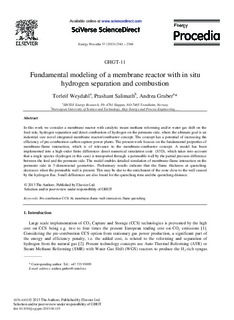| dc.contributor.author | Weydahl, Torleif | |
| dc.contributor.author | Salimath, Prashant Siddlinggayya | |
| dc.contributor.author | Gruber, Andrea | |
| dc.date.accessioned | 2017-12-19T09:10:57Z | |
| dc.date.available | 2017-12-19T09:10:57Z | |
| dc.date.created | 2013-09-04T14:06:26Z | |
| dc.date.issued | 2013 | |
| dc.identifier.citation | Energy Procedia. 2013, 37 2341-2348. | nb_NO |
| dc.identifier.issn | 1876-6102 | |
| dc.identifier.uri | http://hdl.handle.net/11250/2472727 | |
| dc.description.abstract | In this work we consider a membrane reactor with catalytic steam methane reforming and/or water gas shift on the feed side, hydrogen separation and direct combustion of hydrogen on the permeate side, where the ultimate goal is an industrial size novel integrated membrane reactor/combustor concept. The concept has a potential of increasing the efficiency of pre-combustion carbon capture power plants. The present work focuses on the fundamental properties of membrane-flame interaction, which is of relevance to the membrane-combustor concept. A model has been implemented into a high-order finite differences direct numerical simulation code (S3D), which takes into account that a single species (hydrogen in this case) is transported through a permeable wall by the partial pressure difference between the feed and the permeate side. The model enables detailed simulation of membrane-flame interaction on the permeate side in 3-dimensional geometries. Preliminary results indicate that the flame thickness at quenching decreases when the permeable wall is present. This may be due to the enrichment of the zone close to the wall caused by the hydrogen flux. Small differences are also found for the quenching time and the quenching distance. | nb_NO |
| dc.language.iso | eng | nb_NO |
| dc.publisher | Elsevier | nb_NO |
| dc.rights | Attribution-NonCommercial-NoDerivatives 4.0 Internasjonal | * |
| dc.rights.uri | http://creativecommons.org/licenses/by-nc-nd/4.0/deed.no | * |
| dc.title | Fundamental Modeling of a Membrane Reactor with in Situ Hydrogen Separation and Combustion | nb_NO |
| dc.type | Journal article | nb_NO |
| dc.type | Peer reviewed | nb_NO |
| dc.description.version | publishedVersion | nb_NO |
| dc.source.pagenumber | 2341-2348 | nb_NO |
| dc.source.volume | 37 | nb_NO |
| dc.source.journal | Energy Procedia | nb_NO |
| dc.identifier.doi | 10.1016/j.egypro.2013.06.115 | |
| dc.identifier.cristin | 1046872 | |
| dc.relation.project | Norges forskningsråd: 193816 | nb_NO |
| dc.description.localcode | © 2013 The Authors. Published by Elsevier Ltd. This is an open access article under the CC-BY-NC-ND 4.0 license (http://creativecommons.org/licenses/by-nc-nd/4.0/) | nb_NO |
| cristin.unitcode | 194,64,25,0 | |
| cristin.unitname | Institutt for energi- og prosessteknikk | |
| cristin.ispublished | true | |
| cristin.fulltext | original | |
| cristin.qualitycode | 1 | |

